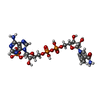+Search query
-Structure paper
| Title | Photocatalytic LPOR forms helical lattices that shape membranes for chlorophyll synthesis. |
|---|---|
| Journal, issue, pages | Nat Plants, Vol. 7, Issue 4, Page 437-444, Year 2021 |
| Publish date | Apr 19, 2021 |
 Authors Authors | Henry C Nguyen / Arthur A Melo / Jerzy Kruk / Adam Frost / Michal Gabruk /   |
| PubMed Abstract | Chlorophyll biosynthesis, crucial to life on Earth, is tightly regulated because its precursors are phototoxic. In flowering plants, the enzyme light-dependent protochlorophyllide oxidoreductase ...Chlorophyll biosynthesis, crucial to life on Earth, is tightly regulated because its precursors are phototoxic. In flowering plants, the enzyme light-dependent protochlorophyllide oxidoreductase (LPOR) captures photons to catalyse the penultimate reaction: the reduction of a double bond within protochlorophyllide (Pchlide) to generate chlorophyllide (Chlide). In darkness, LPOR oligomerizes to facilitate photon energy transfer and catalysis. However, the complete three-dimensional structure of LPOR, the higher-order architecture of LPOR oligomers and the implications of these self-assembled states for catalysis, including how LPOR positions Pchlide and the co-factor NADPH, remain unknown. Here, we report the atomic structure of LPOR assemblies by electron cryo-microscopy. LPOR polymerizes with its substrates into helical filaments around constricted lipid bilayer tubes. Portions of LPOR and Pchlide insert into the outer membrane leaflet, targeting the product, Chlide, to the membrane for the final reaction site of chlorophyll biosynthesis. In addition to its crucial photocatalytic role, we show that in darkness LPOR filaments directly shape membranes into high-curvature tubules with the spectral properties of the prolamellar body, whose light-triggered disassembly provides lipids for thylakoid assembly. Moreover, our structure of the catalytic site challenges previously proposed reaction mechanisms. Together, our results reveal a new and unexpected synergy between photosynthetic membrane biogenesis and chlorophyll synthesis in plants, orchestrated by LPOR. |
 External links External links |  Nat Plants / Nat Plants /  PubMed:33875834 PubMed:33875834 |
| Methods | EM (helical sym.) |
| Resolution | 3.1 Å |
| Structure data | EMDB-22364, PDB-7jk9: |
| Chemicals |  ChemComp-NDP:  ChemComp-PMR:  ChemComp-LMG: |
| Source |
|
 Keywords Keywords | PHOTOSYNTHESIS / reductase / light-activated / ligand-protein complex |
 Movie
Movie Controller
Controller Structure viewers
Structure viewers About Yorodumi Papers
About Yorodumi Papers






